…and a Conversation with Mira Nakashima
by Mike McLeod
George Nakashima’s philosophy reflected his style of craftsmanship: earthy, unexpected, creative, often symmetrical and asymmetrical in the same piece of furniture, elegant and definitely unique. His work, which often incorporates slabs of irregular tree trunks or roots, is highly recognizable and appreciated.
George Nakashima was born on May 24, 1905 in Spokane, WA. His parents moved to America from Japan. After earning a bachelors degree in architecture, George studied in France, then returned to America and earned a masters from MIT. Hired by an architectural firm in Tokyo, one long-term project involved overseeing the building of an ashram dormitory in India. There, he became a disciple of the ashram’s leader Sri Aurobindo, and began to design furniture.
“My father grew up in Seattle and was a boy scout,” George’s daughter Mira Nakashima explained to me. “He often went out by himself in the mountains and felt a wonderful sense of peace there. [At the ashram,] he found the philosophy he was looking for in life. There are different types of yoga, beside the physical discipline, and this philosophy was the yoga of doing (Karma Yoga). It gave him the strength and courage to do what he did.”
At the outset of World War II, George Nakashima returned to America, married Marion Okajima, settled back in Seattle, and had a daughter, Mira. A son, Kevin, joined the family after World War II. Following Pearl Harbor, the family was sent to a Japanese internment camp in southern Idaho. At Camp Minidoka, a carpenter trained in traditional Japanese woodworking improved his attention to detail and he learned to strive for perfection despite a lack of available wood.
While visiting, she met the farmer who employed her father to tend his field of carrots. The farmer related how George told him with tears in his eyes how grateful he was for the job. The farmer was happy to have men from the camp who worked hard and were happy to work. Camp authorities required him to pick up the work crew and then drive them home at day’s end. After a while, the farmer gave his keys to the men and told them to drive themselves, having gained his trust.
Not much remains today of the camp that was 3.5 miles long and one mile wide. During the war years, it held a total of 13,000 people – 9,000 at its peak. Camp Minidoka had 44 housing blocks, each with 12 barracks. A barrack was 20 feet by 120 feet and home to six housing units.
Not fully constructed when the internees began to arrive, every housing block soon had a mess hall, laundry, bathrooms, and an open space for a school, house of worship, and community events. There were libraries, co-op stores, a hospital, theaters, a warehouse, barbershops, a watch repair shop, nine baseball fields and swimming in an irrigation canal. The climate in the Idaho desert was brutal – hot summer days, cold nights, heavy snow in the winter, and volcanic desert dust blowing almost constantly, covering everything. It was reported that dust storms were so heavy darkness fell on the camp.
To many, these hardships pale in comparison with the civil rights that were lost.
However, in light of the controversy surrounding the Allen Eaton Collection of internment art that was going to be auctioned, Mira shed a different light on the internment camps in American history: “The angriest people were not those interned; it was the next generation who weren’t there themselves. It was blown up to be a civil rights thing, but it was an overreaction. Those there just accepted it as that’s the way it is. They came here to America to be free.” Ironically, internment was the price they paid to show their patriotism.
In 1943, the Nakashimas were released thanks to his former employer from Tokyo, Antonin Raymond. They moved to New Hope, PA, where they lived and worked on Raymond’s farm. There, George Nakashima’s philosophy of furniture came to fruition and eventually to acclaim.
George’s discipleship in the ashram and education at Camp Minidoka heightened his innate skills and aesthetic to yield a style of functional beauty. Avoiding ostentation, his work found beauty in purity, highlighting the wood’s character, particularly its gnarled imperfections. His “yoga of doing” found the perfection in imperfection.
“When he first started out and was working with a Japanese carpenter, he used found materials around the camp and bitterbrush from the desert,” Mira recounted. “When he came back here, he didn’t have money for good wood but got cutoffs from the lumber industry and went from there. After Dad was able to get these cutoffs, he made friends with loggers in the area and got trees others didn’t want; then he oversaw the milling to get the right direction and thickness.”
His craftsmanship captivates people “because it is different. My father integrated life and work by not tying into the big-corporation mindset of mass production and making money. To him, it was more important to make beautiful furniture; money would come later. He combined utilitarianism with beauty.
“Dad always felt he was giving trees new life, and life continues. Not everybody understands this; it’s not for everyone, but if you are sensitive to it, you will sense life in each item we make. People realize this when they have sold their Nakashimas. It’s like selling a part of themselves.”
George Nakashima’s sense of beauty continues to enthrall collectors. His work graces the homes of Steven Spielberg, Brad Pitt, Julianne Moore and many others. A Nakashima Conoid Bench, Conoid Chair, Lounge Chair and Minguren II Coffee Table are preserved for history in the Smithsonian.
Today, Mira continues the family tradition of woodworking and furniture making, and she has written a book about her father called “Nature, Form and Spirit: The Life and Legacy of George Nakashima.” Of her father’s influence, she said, “Today, there is a strong legacy that lives all over the world in using the natural form of wood. The architecture he created on the property here [in Bucks County, PA] is now a Historic National Landmark. Another landmark in his life was to leave the camp in the desert and start a legacy here in New Hope.”
Coming from a generation embroiled in war, Nakashima desired peace. “My father had a dream to make Peace Altars for the world. If people could meet around them, we could get a little closer to world peace … sitting or standing around one has a unifying affect.” He planned to build seven Altars of Peace (large tables), one for each of the seven continents. Three have been installed thus far: at the Cathedral of St. John the Divine in NYC; the Russian Academy of Art in Moscow; and a third in Auroville, in Pondicherry, India, part of the Sri Aurobindo Ashram.
George Nakashima passed away on June 15, 1990 in New Hope, leaving the world a legacy of beauty and a hope for peace.



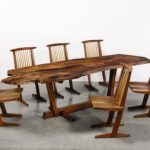
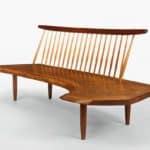
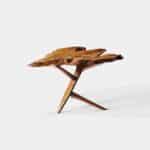

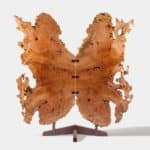
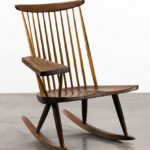



Related posts: